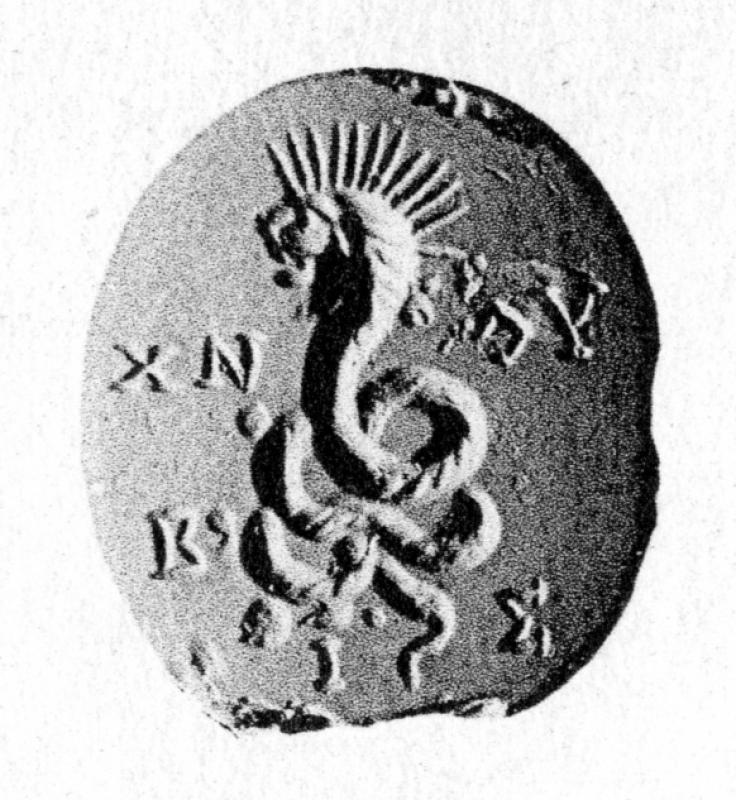Bonner, SMA, 25.
that show Isis with the infant Horus on the obverse (D. 30, 31, 32). More common than any of these are designs using for their principal figure a pantheistic demon of monstrous form, who combines certain attributes of several gods.14 The name “pantheistic Bes” has been applied to this figure, because it is sometimes, though by no means always, given the head of Bes; but it is better to treat it as nameless (D. 251, 252, 253, 254, 255, 256, 257, 258, 259, 260, 261).
A large number of amulets present as their principal design a serpent with the head of a lion adorned with single or double rays, usually seven or twelve in number, sometimes with a nimbus in addition; less often the head is human (D. 83, 84, 85, 86, 87, 88, 89, 90, 91, 92; cf. 95–96). With this type there is regularly the legend Χνοῦβις (variants Χνοῦμις, Χνοῦφις). This serpent god seems to represent a fusion of the Greek Agathos Daimon (later Agathodaimon)15 with Chnum, the ram-headed god of Elephantine, whose name the Greeks sometimes wrote as Κνήφ.16 Agathos Daimon came to be represented in the form of a snake, and one is tempted to regard the serpentine form as the Greek contribution to the compound divinity; but the Egyptians at times represented various gods and many goddesses in the form of snakes, and this characteristic of Chnoubis cannot safely be ascribed exclusively to either influence. The radiate lion's head seems to be a solar attribute developed in Egypt.
Drexler, whose exhaustive article on Chnoubis17 leaves later students little to do but provide further illustrations of his statements, says the Chnoubis of the magical amulets is not the old cosmogonic god Chnum, but one of the thirty-six decan gods, each of whom presided over one third of a zodiacal sign, or ten degrees of the circle. It is true, as he shows, that the name Χνοῦμις appears as one of the decans of the sign Cancer, and that one of the astrological texts that give us the name also describes an amulet, identical with the well-known Chnoubis type, to be worn by those whose birthday falls under the decan Chnoumis. Such people are peculiarly liable to digestive ailments, for which the Chnoubis amulet is a remedy. But the name is almost certainly connected with the ancient Chnum, and it may be doubted whether all Chnoubis amulets were produced under astrological influence. The adoption of the name Chnoumis for a decan may be a secondary development. However, a sign which almost always appears on Chnoubis amulets is certainly associated with Chnum as a decan. In the Egyptian monuments it is an upright snake crossed by three other snakes lying horizontally; on the amulets it is  or
or  .
.
The strength of Egyptian tradition is less striking in the case of single
14 This deity is to be seen on two small Ptolemaic stelae reproduced by Daressy, Textes, Pl. 10, Nos. 9428–9429, and on the top of the reverse side of the Metternich stele (see Pl. XXII, Fig. 6). See also Erman, p. 310; Müller, pp. 222 ff.; Budge, Gods, I, 492.
15 The principal authority on Agathodaimon is R. Ganszyniec, De Agathodaemone (Warsaw, 1919) in Prače Towarzystwa Naukowego, No. 19. For convenience I cite instead his article in PW Suppl. III; see especially pp. 55, 53, 57. Psois or Psai, the deification of good luck, seems to have been identified with Agathodaimon in early Hellenistic times; see Tarn, JHS 48 (1928), 218, and the authorities cited by him.
16 This, however, seems to be a confusion, since Kneph had originally nothing to do with Chnum or Chnoubis; see Ahmad Mohammad Badawi, Der Gott Chnum, p. 13 (Hamburg, 1937).
17 Article “Knuphis,” in Roscher, II, 1, 1250 ff., especially 1260, 1264.
Last modified: 2012-11-05 09:41:22
Link: cbd.mfab.hu/pandecta/1200





















